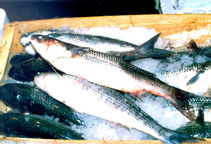| Family: |
Mugilidae (Mullets) |
| Max. size: |
70 cm TL (male/unsexed); max.weight: 2,900.0 g; max. reported age: 10 years |
| Environment: |
pelagic-neritic; freshwater; brackish; marine; depth range 10 - 20 m, catadromous |
| Distribution: |
Eastern Atlantic: from the coasts of southern Norway to Cape Verde, including the Mediterranean and the Black Sea (Ref. 2804, Ref. 51442, 116118). Records of its occurrence in tropical waters are based on misidentifications (Ref. 3573). |
| Diagnosis: |
Dorsal spines (total): 4-5; Dorsal soft rays (total): 7-10; Anal spines: 3-3; Anal soft rays: 8-9. Fusiform body (Ref. 51442). Massive head, flattened above the eyes (Ref. 51442). Small mouth (Ref. 51442). Snout short and blunt (Ref. 51442). Two dorsal fins well-separated, the first with 4 to 5 spines (Ref. 40476, Ref. 51442). Pectoral fins are placed high on the flanks (Ref. 51442). Large scales (Ref. 51442). Dorsal sides and flanks gray-colored, ventral side white (Ref. 51442). |
| Biology: |
Adults are pelagic occurring near shore, entering lagoons and lower reaches of rivers in schools; often in polluted waters (Ref. 51442, 59043) between temperatures 8-24°C. Juveniles colonize the littoral zone and estuaries (Ref. 51442). Adults feed on epiphytic algae, detritus and small benthic or planktonic organisms, pelagic eggs and larvae while juveniles feed on zooplankton until about 3.0 cm SL, then on benthic animals and plants (Ref. 59043). Spawning takes place at sea near the coast between September and February (Ref. 30578, 51442). Oviparous, eggs are pelagic and non-adhesive (Ref. 205). Adults undergo migrations (Ref. 51442). |
| IUCN Red List Status: |
Least Concern (LC); Date assessed: 01 January 2008 Ref. (130435)
|
| Threat to humans: |
harmless |
Source and more info: www.fishbase.org. For personal, classroom, and other internal use only. Not for publication.

